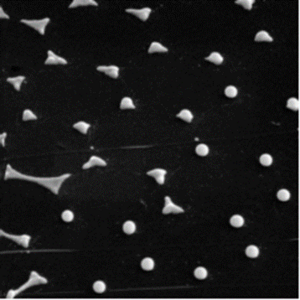
Thin metallic films are typically not stable on oxide surfaces. Thus upon increasing the temperature dewetting will start which finally leads to individual nanoparticles. We study such dewetting processes after a temperature increase induced by a nanosecond laser pulse.
Upon illumination of individual nanostructures (e.g. triangles) with pulsed light the material will melt at a material-dependent threshold energy density. Immediately after melting, the liquid has a contact angle far from equilibrium and thus surface tension rearranges the liquid towards the equilibrium contact angle, which is close to a sphere. This transformation process (flat molten nanostructure towards liquid sphere) which can be seen in the image below happens on a timescale of few nanoseconds. As one can already suspect from the image this transformation is accompanied by an upward-movement of the center of mass. This leads to the jumping of the nanodroplets off the surface with velocities in the range of tens of m/s.
